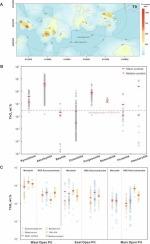The occurrence and distribution of thorium in the giant Bayan Obo REE-Nb-Fe polymetallic deposit, China
IF 3.6
2区 地球科学
Q1 GEOLOGY
引用次数: 0
Abstract
Thorium (Th) is increasingly regarded as a critical element for next-generation nuclear energy systems due to its status as the most abundant fissile material on Earth and its advantageous safety properties. The Bayan Obo deposit in Inner Mongolia (China), contains the largest known reserves of rare earth elements (REE) globally, along with significant amounts of niobium (Nb), iron (Fe), and Th. Despite the considerable Th resources within this deposit, the spatial distribution, occurrence state, and genetic relationship with the REE-Nb-Fe mineralized systems are still poorly understood.
In this study, Th distribution and the intrinsic relationship with REE-Nb-Fe mineralization were investigated by a systematic mineral-geochemical composition analysis (XRF, TIMA, and EPMA) of various rocks and ores in the Bayan Obo deposit. Spatially, Th concentrates along the contact zone (fluorite-rich banded/massive ores) between ore-hosting dolomite and K-rich slate, with four high-Th zones (>200 ppm) in the Main and East open pits. The abundance of Th in ores and rocks exhibits considerable variability, ranging from 1.1 to 587 ppm. This significant heterogeneity in the distribution of Th within the deposit is primarily attributed to Th migration induced by late thermal events, thereby creating scattered Th-Pb ages in the REE minerals. Chemical and mineralogical mapping indicates that Th in the Bayan Obo deposit is primarily hosted in REE minerals, Nb-bearing minerals and thorite. Although Nb-bearing minerals exhibit higher Th concentrations (e.g., aeschynite: 4.1 wt% ThO2), REE minerals (e.g., monazite and fluorocarbonate) dominate Th resource volume due to their extensive distribution. Among these REE minerals, monazite in the disseminated, banded and vein ores of the West Open Pit displays the highest Th content (median >1 wt%). Additionally, the biotite-altered disseminated ore in the Main Open Pit contains elevated Th concentrations, present as thorite and Th-rich monazite. For efficient, resource-specific mining strategies, optimal ore types include: biotite-altered disseminated ores in the Main Open Pit and the disseminated and massive ores in the West Open Pit for Th-REE-Nb, and massive ores in the Main and East open pits for Th-Fe-REE.
Moreover, Th concentrations closely align with REE and Fe but diverge sharply from Nb. Thorium-REE-rich minerals mainly occur in fluorite-rich banded and massive ores, while Nb-bearing minerals concentrate in ores dominated by aegirine and riebeckite, linked to alkaline metasomatism. Geochemical analyses reveal a strong Th-F correlation but no association with K2O or Na2O, which highlighting distinct enrichment-precipitation pathways: the Th-REE-Fe systems rely on fluorination-driven, contrasting sharply with Nb’s alkaline metasomatic origins. These insights guide targeted exploitation strategies and deepen understanding of the deposit’s complex metallogenic history.

白云鄂博REE-Nb-Fe多金属矿床中钍的赋存状态及分布特征
钍(Th)作为地球上最丰富的可裂变物质,以及其优越的安全性能,越来越被视为下一代核能系统的关键元素。中国内蒙古的白云鄂博矿床是全球已知稀土元素(REE)储量最大的矿床,同时还含有大量的铌(Nb)、铁(Fe)和Th。尽管该矿床内Th资源丰富,但其空间分布、赋存状态及其与REE-Nb-Fe矿化系统的成因关系尚不清楚。本文通过对巴彦鄂博矿床各种岩石和矿石的矿物地球化学组成(XRF、TIMA和EPMA)分析,探讨了稀土元素的分布及其与稀土-铌-铁矿化的内在关系。空间上,Th沿含矿白云岩与富钾板岩的接触带(富萤石带状/块状矿石)富集,在主露天矿和东露天矿有4个高Th带(200 ppm)。矿石和岩石中钍的丰度表现出相当大的变化,范围在1.1 - 587ppm之间。矿床内Th分布的明显不均一性主要归因于晚期热事件引起的Th迁移,从而导致稀土矿物中Th- pb年龄分散。化学和矿物学填图表明,白云鄂博矿床中Th主要赋存于稀土矿物、含铌矿物和钍矿中。虽然含铌矿物表现出较高的Th浓度(例如,菱白石:4.1 wt% ThO2),但稀土矿物(例如,独居石和氟碳酸盐)由于其广泛分布而占主导地位。其中,西露天矿浸染状、条带状和脉状矿石中的独居石Th含量最高,中位数为1 wt%。此外,主露天矿黑云母蚀变浸染状矿石中Th含量升高,以钍矿和富Th独居石的形式存在。对于有效的、资源特定的采矿策略,最佳矿石类型包括:主露天矿的黑云母蚀变浸染状矿石和西露天矿的浸染状块状矿石,用于Th-REE-Nb,主露天矿和东露天矿的块状矿石用于Th-Fe-REE。此外,Th浓度与REE和Fe密切相关,但与Nb有明显差异。富钍ree矿物主要赋存于富萤石的条状和块状矿石中,而含铌矿物则富集于以铝辉石和辉沸石为主的矿石中,与碱性交代作用有关。地球化学分析显示Th-F有很强的相关性,但与K2O或Na2O没有关联,这突出了不同的富集-沉淀途径:Th-REE-Fe系统依赖于氟化驱动,与Nb的碱性交代来源形成鲜明对比。这些见解指导了有针对性的开采策略,加深了对矿床复杂成矿历史的认识。
本文章由计算机程序翻译,如有差异,请以英文原文为准。
求助全文
约1分钟内获得全文
求助全文
来源期刊

Ore Geology Reviews
地学-地质学
CiteScore
6.50
自引率
27.30%
发文量
546
审稿时长
22.9 weeks
期刊介绍:
Ore Geology Reviews aims to familiarize all earth scientists with recent advances in a number of interconnected disciplines related to the study of, and search for, ore deposits. The reviews range from brief to longer contributions, but the journal preferentially publishes manuscripts that fill the niche between the commonly shorter journal articles and the comprehensive book coverages, and thus has a special appeal to many authors and readers.
 求助内容:
求助内容: 应助结果提醒方式:
应助结果提醒方式:


